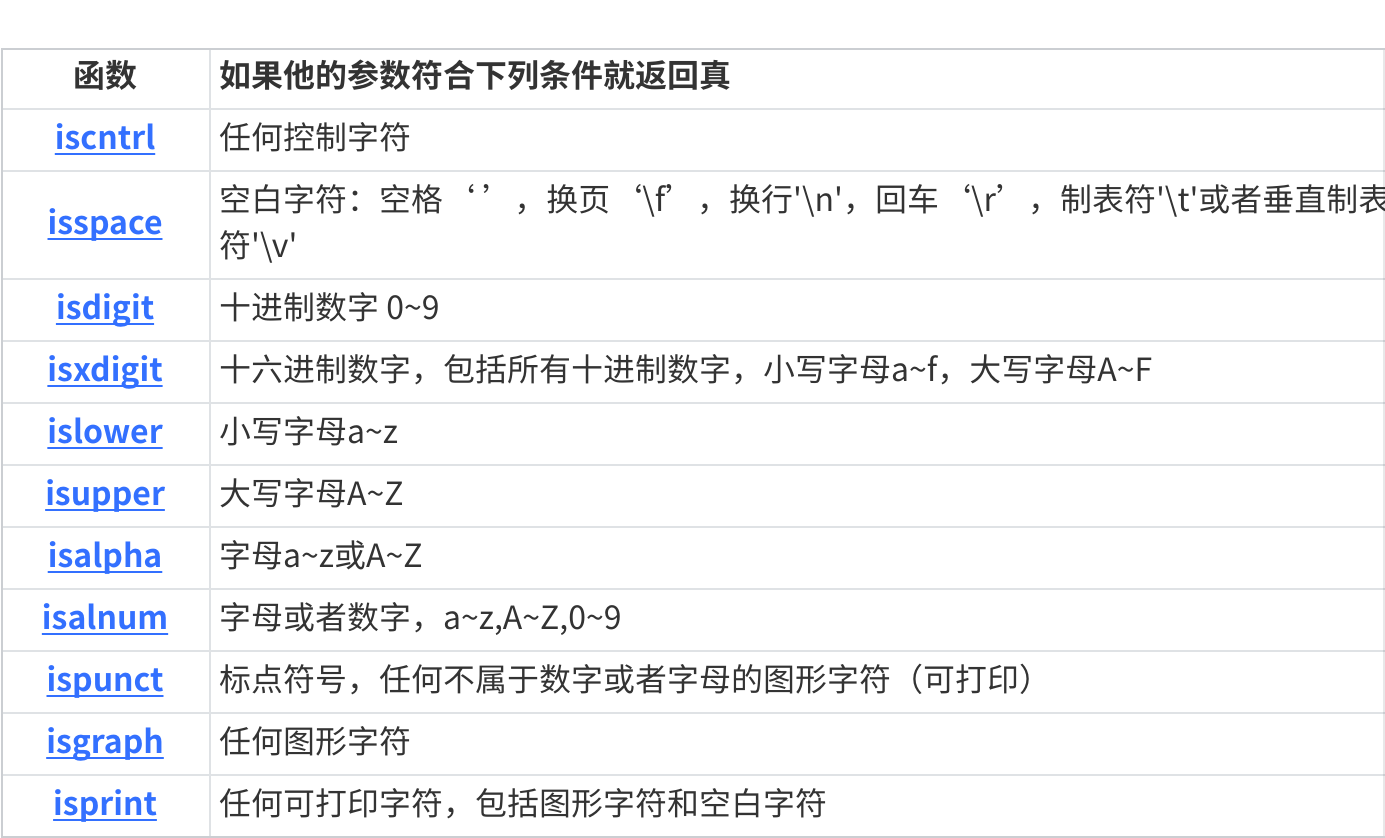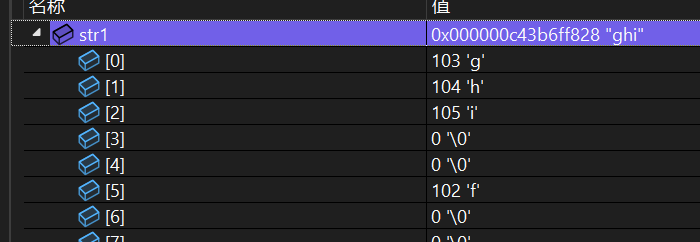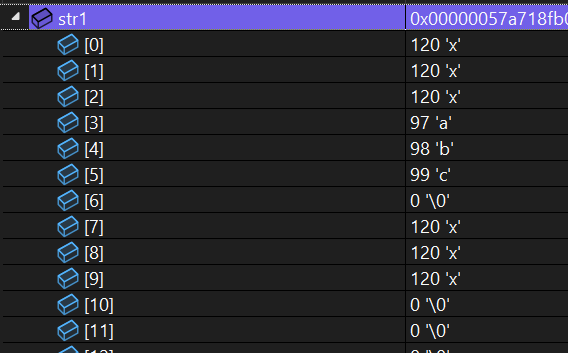字符分类函数
C语言中有⼀系列的函数是专门做字符分类的,也就是⼀个字符是属于什么类型的字符的。
这些函数的使用都需要包含⼀个头文件:ctype.h

这些函数的用法非常类似。
int islower ( int c )
islower是能够判断参数部分是否是小写字母的。
通过返回值来说明是否是小写字母,如果是小写字母就返回非0的整数,如果不是小写字母,则返回0
练习:
写⼀个代码,将字符串中的小写字母转大写,其他字符不变。
#include<stdio.h>
#include<ctype.h>
int main()
{char str[] = "Test String";int i = 0;while(str[i])//'\0'的ASCLL码为0//while (str[i] != '\0'){if (islower(str[i]))str[i] -= 32;//写法一:putcharputchar(str[i]);i++;}printf("\n");//写法二:%sprintf("%s", str);return 0;
}输出结果:
TEST STRING
TEST STRING
字符转换函数
C语⾔提供了2个字符转换函数,头文件为ctype.h
int tolower(int c);//将参数传进去的大写字母转小写字母
int toupper(int c);//将参数传进去的小写字母转大写字母
上面的代码,我们将小写转大写,是-32完成的效果,有了转换函数,就可以直接使用转换函数。
#include<stdio.h>
#include<ctype.h>
int main()
{char str[] = "Test String";int i = 0;while (str[i]){if (islower(str[i]))str[i] = toupper(str[i]);putchar(str[i]);i++;}return 0;
}
strlen的使用和模拟实现
基本用法
strlen是C语言库函数,功能是求字符串长度。
头文件为string.h
size_t strlen ( const char * str );
- 统计的是从
strlen函数的参数str中这个地址开始向后,\0之前字符串中字符的个数(不包含'\0')。 strlen函数会⼀直向后找\0字符,直到找到为止,所以可能存在越界查找。
我们可以通过代码来理解:
#include<stdio.h>
#include<string.h>
int main()
{char arr1[] = "abc";char arr2[] = { 'a', 'b' , 'c' };char arr3[] = { 'a', 'b' , 'c' , '\0' };printf("%s\n%s\n%s\n", arr1, arr2, arr3);int len1 = strlen(arr1);int len2 = strlen(arr2);int len3 = strlen(arr3);printf("%d\n%d\n%d\n", len1, len2, len3);return 0;
}
运行结果为:

我们可以看到,字符串中有\0 和无\0的结果不同,这是因为arr2因为没有\0而打印没有停止,继续打印了一些随机值。
- 函数的返回值为
size_t,是无符号的。
#include<stdio.h>
#include<string.h>
int main()
{if (strlen("abc") - strlen("abcdef") > 0)printf(">");elseprintf("<");return 0;
}
输出结果为>
strlen的返回值为size_t类型,是无符号整型。
无符号整型 - 无符号整型,结果为无符号整型。
模拟实现
方法一
//计数器方式
size_t my_strlen(const char* str)
{assert(str);//assert(str != NULL);size_t count = 0;while (*str){count++;str++;}return count;
}
int main()
{char str[] = "Test String";size_t i = my_strlen(str);printf("%zd", i);return 0;
}
方法二:
//指针 — 指针
#include<stdio.h>
#include<assert.h>size_t my_strlen(const char* str)
{assert(str);//assert(str != NULL);char* p = str;while (*str){str++;}return str - p;
}
int main()
{char str[] = "Test String";size_t i = my_strlen(str);printf("%zd", i);return 0;
}
方法三:
//不创建临时变量——函数递归
#include<stdio.h>
#include<assert.h>size_t my_strlen(const char* str)
{assert(str);//assert(str != NULL);if (*str == '\0')return 0;elsereturn 1 + my_strlen(str + 1);
}
int main()
{char str[] = "Test String";size_t i = my_strlen(str);printf("%zd", i);return 0;
}strcpy的使用和模拟实现
基本用法
strcpy是C语言库函数,功能是字符串的拷贝。
头文件为string.h
char* strcpy(char * destination, const char * source );
- Copies the C string pointed by source into the array pointed by destination, including the terminating null character (and stopping at that point).
- 源字符串必须以\0结束。
- 会将源字符串中的’\0’拷贝到目标空间,拷贝至’\0’`结束。
- 目标空间必须足够大,以确保能存放源字符串。
- 目标空间必须可修改(常量字符串不能作为目标空间)。
strcpy的返回值为目标空间的起始地址(便于链式访问)。
:::
#include<stdio.h>
#include<string.h>int main()
{char arr1[20] = "abcdef";char arr2[20] = "ghijkl";strcpy(arr1, arr2);printf("%s", arr1);return 0;
}
模拟实现
#include<stdio.h>
#include<assert.h>char* my_strcpy (char* des, const char* sour)
{char* p = des;assert(des && sour);while (*des++ = *sour++)//=的返回值为所赋的值{;}//拷贝\0*des = *sour;return p;
}
int main()
{char arr1[20] = "abcdef";char arr2[20] = "ghijkl";my_strcpy(arr1, arr2);printf("%s", arr1);return 0;
}
strcat的使用和模拟实现
基本用法
strcat是C语言库函数,功能是追加字符串。
头文件为string.h
char * strcat ( char * destination, const char * source );
- Appends a copy of the source string to the destination string. The terminating null character in destination is overwritten by the first character of source, and a null-character is included at the end of the new string formed by the concatenation of both in destination.
- 源字符串必须以’\0’结束。
- 目标字符串中也得有’\0’,否则不知道从哪里开始追加。
- 目标空间必须有足够的大,能容纳下源字符串的内容。
- 目标空间必须可修改。
- 返回值为目标空间的地址。
- 不适用于字符串自己给自己追加。
#include<stdio.h>
#include<string.h>int main()
{char arr1[20] = "hello ";char arr2[20] = "world!";strcat(arr1, arr2);printf("%s", arr1);return 0;
}
模拟实现
#include<stdio.h>
#include<assert.h>char* my_strcat(char* des, const char* sour)
{char* p = des;assert(des && sour);//找到'\0'while (*des){des++;}//追加字符串while (*des++ = *sour++){;}return p;
}int main()
{char arr1[20] = "hello ";char arr2[20] = "world!";my_strcat(arr1, arr2);printf("%s", arr1);return 0;
}
注意:strcat`不适用于字符串自己给自己追加。
#include<stdio.h>
#include<string.h>
#include<assert.h>char* my_strcat(char* des, const char* sour)
{char* p = des;assert(des && sour);while (*des){des++;}while (*des++ = *sour++){;}return p;
}int main()
{char arr1[20] = "abc";my_strcat(arr1, arr1);printf("%s", arr1);//陷入死循环//源字符串中的'\0'被破坏return 0;
}
#include<stdio.h>
#include<string.h>int main()
{char arr1[20] = "abc";strcat(arr1, arr1);printf("%s", arr1);//输出 abcabc//在VS中,strcat能够实现字符串自己给自己的追加return 0;
}
strcmp的使用和模拟实现
基本用法
strcmp是C语言库函数,功能是比较字符串。
- This function starts comparing the first character of each string. If they are equal to each other, it continues with the following pairs until the characters differ or until a terminating null-character is reached.
- 比较的不是字符串的长度,而是对应位置 ASCLL 码值的大小。
- 标准规定:
- 第⼀个字符串大于第二个字符串,则返回大于0的数字
- 第⼀个字符串等于第二个字符串,则返回0
- 第⼀个字符串小于第二个字符串,则返回小于0的数字
#include<stdio.h>
#include<string.h>int main()
{int i = strcmp("abcde", "abq");printf("%d", i);//输出 -1return 0;
}
#include<stdio.h>
#include<string.h>int main()
{int r = strcmp("abcdef", "abq");if (r == 1)printf("字符串一大于字符串二");else if (r == 0)printf("字符串一等于字符串二");elseprintf("字符串一小于字符串二");return 0;
}这串代码正不正确?
在VS2022等部分编译器中,是正确的,因为这些编译器的返回值只为-1,1,0。
模拟实现
方法一
//VS2022中的写法
#include<stdio.h>
#include<assert.h>int my_strcmp(const char* str1, const char* str2)
{while (*str1 == *str2){if (*str1 == '\0')return 0;str1++;str2++;}if (*str1 > *str2)return 1;elsereturn -1;
}
int main()
{int i = strcmp("abcde", "abq");printf("%d", i);return 0;
}
方法二
#include<stdio.h>
#include<assert.h>int my_strcmp(const char* str1, const char* str2)
{while (*str1 == *str2){if (*str1 == '\0')return 0;str1++;str2++;}return *str1 - *str2;
}
int main()
{int i = my_strcmp("abcde", "abq");printf("%d", i);return 0;
}
strncpy函数的使用
strncpy是C语言库函数,功能是字符串的拷贝。
头文件为string.h
char * strncpy ( char * destination, const char * source, size_t num );
- 拷贝
num个字符从源字符串到目标空间。 - 如果源字符串的长度小于
num,则拷贝完源字符串之后,在目标的后边追加\0,直到num个。 - 返回值为目标空间的地址。
#include<stdio.h>
#include<string.h>int main()
{char str1[20] = "abcdef";char str2[20] = "ghi";strncpy(str1, str2, 5);printf("%s", str1);return 0;
}

strncat函数的使用
char * strncat ( char * destination, const char * source, size_t num );
- 将source指向字符串的前num个字符追加到destination指向的字符串末尾,再追加⼀个\0字符
- 如果source指向的字符串的长度小于num的时候,只会将字符串中到\0的内容追加到指向的字符串末尾。
- 返回值为目标空间的地址。
#include<stdio.h>
#include<string.h>int main()
{char str1[20] = "abc";char str2[20] = "defghi";strncat(str1, str2, 3);printf("%s", str1);return 0;
}
#include<stdio.h>
#include<string.h>int main()
{char str1[20] = "xxx\0xxxxxx";char str2[20] = "abc";strncat(str1, str2, 6);printf("%s", str1);return 0;
}

注意:字符串给自身追加的操作用**strncat**更安全。
#include<stdio.h>
#include<string.h>int main()
{char str1[20] = "abcdefghi";size_t len = strlen(str1);strncat(str1, str1, len);printf("%s", str1);//输出 abcdefghiabcdefghireturn 0;
}
strncmp函数的使用
int strncmp ( const char * str1, const char * str2, size_t num );
- 比较str1和>str2的前num个字符,如果相等就继续往后比较,**最多比较num<个字母,如果提前发现不⼀样,就提前结束,大的字符所在的字符串大于另外⼀个。如果字符都相等,就是相等返回0
- 比较的不是字符串的长度,而是对应位置 ASCLL 码值的大小。
- 标准规定:
- 第⼀个字符串大于第二个字符串,则返回大于0的数字
- 第⼀个字符串等于第二个字符串,则返回0
- 第⼀个字符串小于第二个字符串,则返回小于0的数字
#include<stdio.h>
#include<string.h>int main()
{char str1[20] = "abcdefg";char str2[20] = "abcde";int i = strncmp(str1, str2, 7);printf("%d", i);//输出 0return 0;
}
strstr的使用和模拟实现
strstr是C语言库函数,功能是在字符串中查找子串。
头文件为string.h
基本功能
char * strstr ( const char * str1, const char * str2);
- Returns a pointer to the first occurrence of str2 in str1, or a null pointer if str2 is not part of str1. (函数返回字符串str2在字符串str1<中第⼀次出现的位置)。
- The matching process does not include the terminating null-characters, but it stops there. (字符串的比较匹配不包含\0字符,以\0作为结束标志)。
#include<stdio.h>
#include<string.h>int main()
{char str1[20] = "abcdefabcdef";char str2[20] = "def";char* p = strstr(str1, str2);if (p == NULL)printf("找不到");elseprintf("找到了");return 0;
}
模拟实现
#include<stdio.h>
#include<string.h>
#include<assert.h>char* my_strstr(const char* str1, const char* str2)
{assert(str1 && str2);//强制类型转换,更加规范char* p1 = (char*) str1;char* p2 = (char*) str2;if (!*str2/* *str2 == '\0' */)return (char*)str1;while (*p1){//多次匹配保留起始位置char* s1 = p1;char* s2 = p2;while (*s1 && *s2 && !(*s1 - *s2)/* *s1 == *s2 */){s1++;s2++;}if (!*s2)return p1;p1++;}return NULL;
}int main()
{char str1[20] = "abcdefabcdef";char str2[20] = "def";char* p = my_strstr(str1, str2);if (p == NULL)printf("找不到\n");else{printf("找到了\n");printf("%s", p);}return 0;
}
strtok函数的使用
char * strtok ( char * str, const char * sep);
● sep参数指向⼀个字符串,定义了用作分隔符的字符集合
● str参数指定⼀个字符串,它包含了0个或者多个由sep字符串中⼀个或者多个分隔符分割的标记。
● strtok函数找到str中的下⼀个标记,并将其用\0结尾,返回⼀个指向这个标记的指针。(注:strtok函数会改变被操作的字符串,所以在使用strtok函数切分的字符串⼀般都是临时拷贝的内容并且可修改。)
● strtok函数的第⼀个参数不为NULL,strtok函数将保存它在字符串中的位置。
● strtok函数的第⼀个参数为NULL,函数将在同⼀个字符串中被保存的位置(存放于一个静态变量中)开始,查找下⼀个标记。
● 如果字符串中不存在更多的标记,则返回NULL指针。
#include<stdio.h>
#include<string.h>int main()
{char arr1[] = "zpw@bitedu.net";const char arr2[] = "@.";char* p = strtok(arr1, arr2);printf("%s\n", arr1);//输出 zpwprintf("%s\n", p);//输出 zpwreturn 0;
}
#include<stdio.h>
#include<string.h>int main()
{char arr1[] = "zpw@bitedu.net";const char arr2[] = "@.";char* r = NULL; char* p1 = strtok(arr1, arr2);char* p2 = strtok(r, arr2);printf("%s\n", p1);//输出 zpwprintf("%s\n", p2);//输出 biteedureturn 0;
}
strerror函数的使用
基本用法
char * strerror ( int errnum );
strerror函数可以把参数部分错误码对应的错误信息的字符串地址返回来,头文件为string.h。
在不同的系统和C语言标准库的实现中都规定了⼀些错误码,⼀般是放在errno.h这个头文件中说明的,C语言程序启动的时候就会使用⼀个全面的变量errno来记录程序的当前错误码,只不过程序启动的时候errno是0,表示没有错误,当我们在使用标准库中的函数的时候发生了某种错误,就会讲对应的错误码,存放在errno中,而⼀个错误码的数字是整数很难理解是什么意思,所以每⼀个错误码都是有对应的错误信息的。strerror函数就可以将错误对应的错误信息字符串的地址返回。
#include<stdio.h>
#include<string.h>
#include<errno.h>int main()
{int i = 0;for (i = 0; i <= 10; i++){printf("%d:%s\n", i, strerror(i));}return 0;
在vs2022 + windows11环境下,输出结果为:
0:No error
1:Operation not permitted
2:No such file or directory
3:No such process
4:Interrupted function call
5:Input/output error
6:No such device or address
7:Arg list too long
8:Exec format error
9:Bad file descriptor
10:No child processes
#include<stdio.h>
#include<string.h>
#include<errno.h>int main()
{FILE* pf = fopen("test.txt", "r");//以读的形式打开文件if (pf == NULL){//打开文件失败printf("错误信息是:%s\n", strerror(errno));//输出 错误信息是: No such file or directory}return 0;
}
perror函数的使用
void perror(const char* str);
#include<stdio.h>
#include<string.h>
#include<errno.h>int main()
{FILE* pf = fopen("test.txt", "r");//以读的形式打开文件if (pf == NULL){//打开文件失败perror("错误信息是");//输出 错误信息是: No such file or directory//在括号中加字符串时,会自动添加':'和' 'printf("错误信息是: %s\n", strerror(errno));//输出 错误信息是: No such file or directory}return 0;
}



